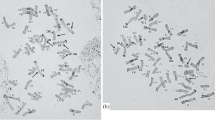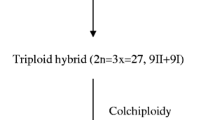Summary
Several weedy forms of rye which have been variously recognized as varieties, subspecies or even species, and a new collection of primitive rye were crossed with the cultivated variety ‘Merced.’ They all crossed readily and produced vigorous F1’s with normal meiosis and with F1 pollen fertility nearly as high as that of the parental materials. No evidence of structurel differences between the genomes of weedy ryes and cultivated rye was found. On the grounds of similar chromosome arrangements, identical breeding habits, equal periodicity, morphological continuity, crossability, regular meiotic behavior of their hybrids, normal F1 pollen fertility and geographical continuity, it is concluded that all these forms should be recognized as subspecies ofS. cereale.
Study of the meristematic activity of the seedlings of four strains of rye showed that forms with larger grains had greater meristematic activity, while those with smaller grains had less. It is concluded that large-grained forms originated probably by the accumulation of mutations causing increase in grain size because large-grained forms had adaptive advantage due to their better competitive ability. Similarly, it is suggested that the stiff rachis evolved due to unconscious selection by primitive farmers for polygenes conditioning that character.
A figure showing the distribution of weedy ryes and the centers of maximum diversity is given. It is concluded that rye was first domesticated at several places independently and at different times. Cultivation of rye probably entered Europe by two routes: through northern Caucus and through central Asia.
Similar content being viewed by others
Literature Cited
Antropov, V. F. and V. I. Antropov, 1929. Eye in U.S.S.R and the adjoining countries. Bull. Appl. Bot.36: 1–330.
Antropov, V. I. and V. F. Antropov. 1936. Rye-Secale. In Flora of Cultivated Plants. Vol. 2. 447 pp. State Agricultural Publishing Company. Moscow-Leningrad. (E. W. Wolf, Edit.)
Bensin M. 1933. Autogamous Turkestan rye (Secale turkestanicum). Bull. Torr. Bot. ClubLX: 155–160.
Berkner, F. and K. Meyer. 1927. Morphologische studien on Roggenähren aus Anatolien. Zietschrift für Pflanzenzüchtung12: 229–245.
Hjelmquist, H. 1955. The prehistory of cultivated plants in Sweden. Op. Bot., Lund1: 1–186.
Khush, G. S. 1960. Cytogenetic and Evolutionary Studies in GenusSecale. Ph.D. thesis. Library, University of California, Davis, 145 pp.
--1962. Cytogenetic and evolutionary studies inSecale. II. Interrelationships of wild species. Evolution16 (In press).
—— and G. L. Stebbins. 1961. Cytogenetic and evolutionary studies inSecale. I. Some new data on the ancestry ofS. cereale. Amer. Jour. Bot.48: 723–730.
Kranz, A. E. 1957. Populationsgenetische Untersuchungen am iranischen Primitivroggen. Ein Beitrag zur Systematik, Evolution und Züchtung des Roggens. Zeitschrift für Pflanzenzüchtung38: 101–146.
Müntzing, A. 1959. Darwin’s views on variation under domestication in the light of present-day knowledge. Proc. Am. Phil. Soc.103: 190–220.
Nürnberg-Krüger, U. 1960. Cytogenetisehe Untersuchungen der GattungSecale L. Zeitschrift für Pflanzenzüchtung44: 63–72.
Roshevitz, B. Y. 1947. A monograph of the wild, weedy and cultivated species of rye. Acta. Inst. Bot. Nomine. Acad. Sci. U.S.S.R. Ser. 1 Fl. et Syst.6: 105–163.
Scheibe, A. 1935. Die verbreitung von Unkrautroggen und Toumalloch in Anatolien. Angew. Bot.17: 1–22.
Schiemann, E. 1943. Entstehung der Kulturpflanzen. Ergebnisse der Biologie19: 409–552.
——. 1948. Weizen, Roggen, Gerste. Systematik, Geschichte und Verwendung. Fischer, Jena. 101 pp.
—— and U. Nürnberg-Krüger. 1952. Neue Untersuchungen anSecale africanum Stapf. II.Secale africanum und Seine Bastarde mitSecale montanum undSecale cereale.Naturwiss.39: 136–137.
Schulz, A. 1918. Abstammung und Heimat de Roggens. Ber. dtsch. Bot. Ges.36: 39–47.
Schwanitz, F. 1957. Die Entstehung der Kulturpflanzen. Springer-Verlag, Berlin. Gottingen. Heidelberg. 151 pp.
Stebbins, G. L. 1950. Variation and Evolution in Plants. Columbia University Press. 643 pp.
—— and S. K. Jain. 1960. Developmental studies of cell differentiation in the epidermis of monocotyledons. I.Allium, Rhoe, andCommelina. Develop. Biol.2: 409–426.
—— and S. S. Shah. 1960. Developmental studies of cell differentiation in the epidermis of monocotyledon. II. Cytological features of stomatal development in the Gramineae. Develop. Biol.2: 477–500.
Vavilov, N. I. 1917. On the origin of cultivated rye. Bull. App. Bot.10: 561–590.
——. 1926. Studies on the origin of cultivated plants. Bull. Appl. Bot.16: 1–248.
—— and D. D. Bukinich. 1929. Agricultural Afghanistan. Bull. Appl. Bot. Suppl.33: 534–536.
Werneck, H. L. 1951. Ur und frühgeschichtliche, Roggenfunde in den Ostalpen und am Ostrande des Böhmerwaldes. Züchter21: 107–108.
Zhukovsky, P. M. 1928. A new wild growing form of rye in Anatolia. Bull. Appl. Bot.19: 49–56.
——. 1933. Roggen (La Turquie Agricole) Vsesoiûzn Akad. Selsk. Khoz. Nauk Lenina, Inst. Rastenievod. Moscow-Leningrad. 834 pp.
Author information
Authors and Affiliations
Rights and permissions
About this article
Cite this article
Khush, G.S. Cytogenetic and evolutionary studies inSecale III. Cytogenetics of weedy ryes and origin of cultivated rye. Econ Bot 17, 60–71 (1963). https://doi.org/10.1007/BF02985354
Received:
Issue Date:
DOI: https://doi.org/10.1007/BF02985354




